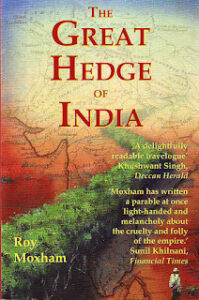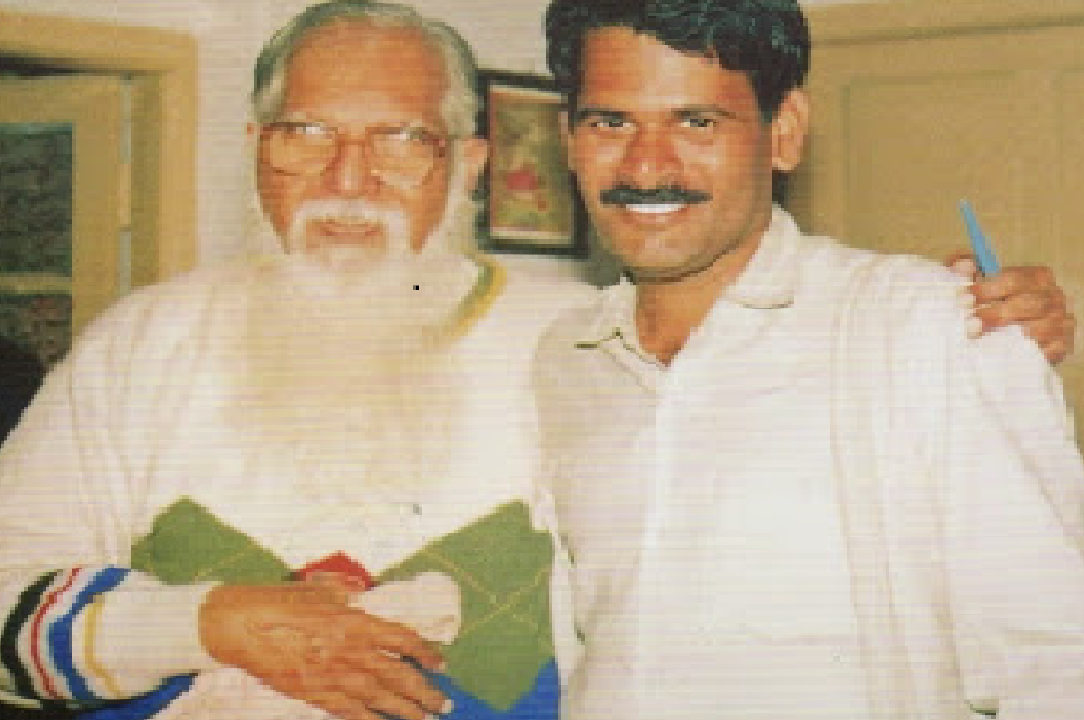
The Great Wall of China stands till today as a historical achievement. There was another in India in the 18th century which was comparable to that. A grand hedge – starting from Maharashtra’s Barhanpur passing via Madhyapradesh, via Uttarpradesh via Punjab, via the Sindh province of Pakistan and ending almost in the Kashmir border.
It was a living fence. Grown from shrubs and tied together so that nobody can cross it. It was almost 12 feet in height. It was the largest fence in the history of the world. It almost split northern India in half. It ran across 4000 kms of vacant land, agriculture land, villages, cities and deserts. At its height, in 1872, it had 14000 full time British officers guarding and maintaining it. It lasted as a symbol of British-Indian Government’s authority for almost three-fourths of a century.
None of India’s historians have mentioned this great structure. It has not been mentioned in any book on India. There is no record of it in the official records of independent India. Even in India, no sociologist or economist had even heard about it – till 1995.
A travel writer and record-keeper of the London Library, Mr. Roy Moxham bought Major General W.H. Sleeman’s ‘Memoirs of a British Soldier’ from an old book shop in London. It was published in 1893. Sleeman had travelled across India as a British Army officer in the 1850s. In his travel notes, there were records and descriptions of kings, chieftains, robbers, holy cities, temples and the taxation system of the then British Indian Government. In this, Sleeman speaks about the great living fence.
Roy Moxham is surprised. He wonders if this were an imagination. He examines British records. Most of them were from the post-1870’s. There was no information about the great fence. He patiently searches in the well-maintained British Library in London. The fact that he is a librarian for historical documents by profession helps him. Finally, he gets information on the survey details of the fence and about its establishment and maintenance.
Initially thinking of it as insanity on the part of the British, Roy Moxham slowly identifies the horrible exploitation behind it. After extensive research, he describes it in his book ‘The Great Hedge of India’.
The Great Hedge of IndiaIt had the objective of controlling salt trade within the nation. It was even called the Customs Hedge. The customs duty on salt was the major source of income of the then British Government. Since the time they gained ground in India, 1803, the British started building this to bring salt distribution under their control to levy taxes. In stages, it was completed in 40 years. In 1843, this hedge was completed and brought under the control of the Inland Customs department.
To understand this, we need to understand Indian geography and the place of salt in it. India’s northern regions are widely distributed. It has enormous plains which are distant from the sea. Northeastern states, the Himalayan regions, well-populated Bihar, Uttar Pradesh, Madhya Pradesh were all dependent on southern coastal regions for salt.
It was in Gujarat’s Kutch peninsula that salt was produced the most. In this region, there are no major rivers meeting the sea. Hence salt is in abundance. For most part of the year, there is abundant sun. In summer, salt lakes like the Sambar dry up naturally into salt beds. Hence traditionally, salt went from Gujarat to the northern states. There were long salt trade routes for this purpose. Maharashtra and Orissa coasts too produced salt. These too went to the northern states and the Himalayan regions through the land route.
Okay, if so, then why a hedge till Kashmir? In today’s Pakistan, the Himalayan regions contain the world’s largest salt mountains. Its pristine pure and cheap as well. For the Himalayan regions including Tibet, it was this salt that was being transported. To block it, this hedge was built there.
Is salt such an important commercial good? Yes, says Roy Moxham. Most of the villages in the India of those times were self-sufficient. The needs of the people like grains, vegetables, ghee and other consumer needs like clothes, weapons were all produced from within the village communities. Salt was the only commodity which had to come from outside. Hence at that time, it was the most important traded commodity.
Was salt so indispensable? Salt is not considered an essential need today. This is because nowadays it is contained in several food products which are processed, stored and consumed. Meat contains salt. But in those days, a farmer’s usual food was made of grains and vegetables alone. He had to include salt in his food. Also, the Indian farmer lost a lot of salt labouring in the sun – this loss he had to remedy with salt intake. Also, in the northern states, salt was in shortage. Animals cannot consume salt from the earth – they too have to be fed with salt.
We can estimate the requirement of salt by considering the population of the northern states. For a trade of that much quantity of salt – what a market it was! We can guess the price it would have acquired as multiples of the cost by the time the salt came from Gujarat and Orissa over thousands of kilometers through bullock-carts and donkeys.
Roy Moxham estimates the cost of salt per annum for an Bihari farmer to be around his monthly income. The people from the hills spent roughly the same amount on salt that they spent on food grains!
Salt has been a scarce good. In some places, it has been even used as currency. Since it had to be saved through the rainy season, lending salt was considered a great aid. Promising over salt was considered a very serious thing.
Was salt thus essential? Everyday around 1500 to 2500 milligrams of sodium is required for every human. He mentions on the basis of research studies that in a tropical region like India where salt leaves the body during the day, a minimum of two ounces of salt is required. Failing which they fall prey to a disease called Hyponatremia. Children are affected the most. The biggest problem with salt deficiency diseases are that the patient or the physician do not easily realise that this is caused by deficiency of salt.
Salt helps maintain the equilibrium of liquids in the body. When it is deficient, blood loses its weight. Hence the body loses liquids and hence blood pressure reduces. Patients experience nausea, faintness and loss of equilibrium. Faintness of breath and giddiness ensues. Death happens if these continue. In India which suffered from hunger, salt deficiency diseases were considered as loss of strength due to hunger. Hence it easily consumed lives.
This enormous trade was under control of the Mughals as well. But their taxes were perfunctory and minimal. They didn’t attempt to control the distribution of salt. The British accomplished it through the customs hedge.
Roy Moxham tells the history of how it was created. In the beginning, the British annexed Bengal. In Bengal, it is difficult to produce salt. Because of the inflow of the Ganges, salt is scarce there. Hence people extracted salt by making it evaporate and then by boiling it using firewood. This was done by people who lived at the lowest strata of society. It costed too much as well.
Since it was boiled, Bengali Brahins wouldn’t consume it. It was equivalent to cooked food. Hence sun-dried salt from Orissa was procured. Clive won over the Nawab of Bengal in the Battle of Plassey and established a comprehensive taxation system all over Bengal. He multipled the taxes on salt factories. It became an important source of income.
This made the price of salt higher than the salt coming from Orissa. Hence it became necessary to heavily tax the salt coming in from Orissa. This is how the British came to establish customs check-posts along the banks of the Mahanadhi in the Orissa-Bengal border. The first check-post came up in Orissa’s Sonapur. From it till Chandrapur, a customs fence was created.
Slowly, British authority spread to Bihar and Uttarpradesh. Hence they extended the customs check-posts till Burhanpur. The British identified the gains through customs duty on salt. They were willing to invest lots of money for it. It was difficult to keep the vast expanse of Madhya Pradesh’s plains under customs purview. Hence came the idea of a massive fence. This is how the customs hedge appeared till Burhanpur.
At the same time, in 1823, the customs commissioner of Agra, George Saunders established a hedge from Mirzapur till Allahabad via the banks of the Ganges and the Yamuna. From Allahabad till Nepal and from there till the Sindh, G. H. Smith established a hedge in 1834. They went on setting up customs checkpoints along the roads and connecting the checkpoints with this hedge. This is how the customs hedge was established.
In the beginning, this hedge was made up of dried wood and bamboo. Deep trenches were dug up on either side of the hedge. But it was difficult to protect this hedge. Every year, it was destroyed by catching fire or by rotting. It was expensive to maintain. It was then that Hume came to power as Commissioner of Customs. Staying on in power for three years, he analysed the cost of maintaining this hedge. He discovered that though converting it into a living fence was expensive to setup, it will become unnecessary to maintain it within a few years. He created this living hedge by identifying thorny bushes which will grow easily to a height and then by planting them.
Alan Octavian Hume is an important personage in curtailing the first Indian Independence revolt, namely the Sepoy Revolt. It is surprising that he was instrumental in setting up the greatest exploitation machinery of the British over India. Because, in later years, he became involved in Indian philosophy and spirituality. He insisted on greater right of self-determination for Indians.He argued for higher representation for Indians in administration and attempted to create an organisation towards that end. The Congress, which went on to win India independence under Gandhi was created in 1885 like this.
The details provided by Roy Moxham are enough to depress us. Firstly, Roy Moxham describes how rampant corruption was the natural course of administration from the days when the British government took shape in India. Clive won over India through corruption. Coming to India as an ordinary British clerk, he became one of the top ten richest in Britain through corrupt monies. At that time most British officials became rich through extensive corruption within very short times.
Also, the Company made low rung employees work for very low wages or for no wages. It encouraged them to earn through corruption. This is how thousands of Indians eagerly came to work for the British East India company. This is how the British created the bureaucratic setup they needed within a few years itself. In other words, our bureaucracy that exists till today is a setup that was created by corruption for corruption.
Whenever officials indulged in corruption like this, the most affected were the poorest of people. These taxes were levied such that they affected only the Indian poor who lived without any protection of aggregate strength while carefully not causing losses to the landlords who supported the British. Thats why the importance to the customs duty on salt. The British government was not the saviour of the depressed and dalit classes like a few write today – it was one that pushed them towards destruction by exploiting them.
Of the great famines that came in India due to the British rule, in the Second Great Famine during 1876-78, around six and a half crore people starved to death. This was around one fourth of the then Indian population. Of that around 30 lakh people died in the then united Bengal. This was the great famine in world history. This book describes accurately that this was not merely a famine, but a massacre caused by economic exploitation. It can only be considered as surprising that this portion of history which our foreign-worshipping historians gloss over, has been depicted thus decisively by an English researcher and a grandson of a British Indian officer.
What are the factors which caused the Famine? The author states that British records state that the years before the famine started, 1874 and 1875 saw great harvests all across northern India. Usually a good harvest in India has the capacity to withstand famine for up to five years. Because the consumption of the average Indian was less as it is today. If so, how did the famine happen?
This was because of the railways laid in India. All these railways were laid to connect the midlands to the ports. Through them, the harvests of India were collected and exported through ships out of India. These went to feed the endless food requirements of the British Empire which was involved in imperial expansionist wars all over the world. Before that, the harvest would be stored in that place itself, for use during famines. Through the railways a situation arose where there was no surplus.
Secondly, the great hedge of the British. In these years, Punjab had record harvests. Andhra and Maharashtra too had decent harvests. This hedge disconnected these regions from the Bengal completely. When lakhs of people were dying in Bengal, shiploads of grains were being exported from Bombay and Madras.
Lastly, Roy Moxham mentions the salt tax. Even during these great famines, the British did not revoke the salt tax. Even in united Bengal and the north east, salt was expensive. Hence people who couldn’t even buy grains, avoided salt completely. Children and animals died due to salt deficiency. From the medical reports of those who died during the famine, medical experts later on found outthat lakhs of them died due to salt deficiency.
Thus the great hedge handcuffed India. It served as a very real basis for British authority over India. It was sucking the life of India like a cancer.
After establishing ports and railways,when the British gained complete economic control over India, they were able to levy taxes on all goods. Hence the salt tax lost its importance. Moroever, the direct tax on Southern salt factories yielded more income than the customs levies on salt through the great hedge. Hence Viceroy Lord Litton revoked the customs duty on salt in 1879. The restrictions on salt distribution were relaxed. The great hedge created for salt was given up and was destroyed.
I have been reading about Gandhi’s Salt Satyagraha since my childhood days. It has been written about from several perspectives. Why did Gandhi take the decision to oppose the Salt Law when there were several burning issues, several oppressive laws in India?
Till today, this has been the explanation given. That when the British imported clothes to India, they filled up the lower part of their ships with salt for weight. It was expensive. To sell it, they had to levy tax on local salt and make it equally expensive. Gandhi launched the Salt Satyagraha since the salt tax was affecting all the deprived classes of people.
It is only partly true. That is to say – only in Bengal. Salt in Bengal was already expensive. Brahmins wanted to buy salt that was not cooked over a fire. The British sold sea salt in its place. To maintain parity, they levied high taxes on locally produced salt. But it is not true on a pan-India basis.
The details provided in this book reveal instantly the entire sociological background of the Salt Satyagraha movement. These have never been discussed in the Indian environment till now. The Salt Satyagraha has been described as one of Gandhi’s quirks of insanity here. Marxist socialist historians have ridiculed the Salt Satyagraha from Gandhian times till today in their writings.
This information background shows us how Gandhi stood at an unreachable height in his knowledge of history and broad social understanding above his contemporary politicians and our contemporary historians. None of them – then and today had idea of what salt meant in Indian history. They hadn’t realised the place of salt in culture and social psychology.
This is because none of them knew the lowest classes of society. Even when fighting for them, these people considered themselves as their leaders and guides and never as one among them. For instance, the ridiculing essays written by Marxist luminary M. N. Roy on the Salt Satyagraha. M. N. Roy was not conversant with the Indian poor by travelling across India. Gandhi was forever one among them. Hence the true history that was hidden to M. N. Roy was evident to Gandhi.
Roy Moxham points out something subtle. India has always had this duality of land tax x salt tax. Land tax affected the owners of the land. Salt tax affected the lowest classes of society. The British government was always forced to increase the salt tax by the upper classes in India.
When the Salt Satyagraha was launched on 12 March 1930, even in the memories of the next generation villagers, the former oppression of the salt tax disappeared. Comparatively, the tax on salt was lower. It was not even a problem in the southern states.
But salt had deep moorings in language and culture. Even the word salt evoked strong emotions. This Gandhi had known travelling and living with these people in third class railway compartments. Gokhale, Tilak, Nehru, Subhash Chandra Bose or Ambedkar didn’t know this. Hence they could only understand the Salt Satyagraha as the quirk of an unavoidable old man. When it gave inexplicable
results, nor were they able to provide explanations.
Roy Moxham mentions how Congress leaders around Gandhi suggested to him to protest against the Land tax or against customs when Gandhi announced his Salt Satyagraha. Gandhi rejected these suggestions. The reason he gave them was that his inner soul commanded him to start the Salt Satyagraha. Land was
a problem for the upper classes and castes. Salt was a problem for the lower classes and dalits. His inner soul knew more history than any intellectual today who ridicules his inner soul.
This book exposes the lack of basis of the research of our sociologists who have written several thousand books in the last sixty years of academic activity in India. In 1996, almost after half a century of Indian Independence, after three fourths of a century after the Salt Satyagraha – Roy Moxham visits India to meet Indian historians, sociologists and political commentators to enquire about this hedge. He is surprised that nobody has any knowledge of it.
How will they have? Here, the facility to travel and to examine records is available only to those who research according to our education. They have a firm belief that modern research lies only in quoting western researchers. Those who research with a little bit of method are those who have received degrees from abroad. They come here after almost religiously believing the principle that the backward Indian plains were built into a modern nation only through the British.
Roy Moxham’s book is interesting and eminently readable. Truly it is a travelogue. Roy who comes to India searching for the Great Hedge travels within India. He sleeps in a village on the banks of the Yamuna on coir cots with buffaloes breathing on his nape. Travels in unreserved compartments with
the bulging crowds. He prays to Lord Shiva in Omakareswar and in Kashi to show him the hedge. Feeling that it is a bit too much, he also asks for his family’s wellbeing.
Several things make one smile. Roy Moxham thinks of those who travel in the first class coupe in India as uncivilised and arrogant. They constantly scream into mobile phones. It is impossible to watch the scenery outside. In the second class compartments, there is a sociable atmosphere. My experience has been so too. The slight humor in his notes about his travel make this book an interesting read.
Finally Roy Moxham identifies the remnants of the hedge in Sambal. From the help of a former brigand-cum-current-priest-of-a-Hanuman-temple. In most other places, modernisation has destroyed this hedge. The reason is simple. Most highways came up along this hedge. The roads expanded and swallowed the hedge.
This is an important book that provokes us to examine ourselves. The customs hedge is the mark of a whiplash on our backs. Even if it disappears, it will remain in our language and our dreams.
Translated By Gokul











